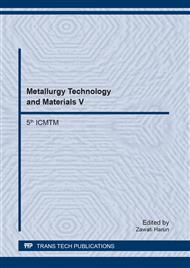[1]
R. Kalhor, H. Akbarshahi, and S. W. Case, Numerical modeling of the effects of FRP thickness and stacking sequence on energy absorption of metal–FRP square tubes, Composite Structures, vol. 147, pp.231-246, (2016).
DOI: 10.1016/j.compstruct.2016.03.038
Google Scholar
[2]
T, Abbas, H. Ya, and M.Z. Abdullah, Energy absorption capability of aluminium tube partially wrapped with glass/epoxy subjected to quasi-static loading. ARPN Journal of Engineering and Applied Sciences, vol. 11, NO. 24, DECEMBER, (2016).
DOI: 10.4028/www.scientific.net/msf.904.61
Google Scholar
[3]
T, Abbas, H.H. Ya, and M. Zaki, The effect of fiber angles on energy absorption of 50% partially wrapped aluminium‐composite hybrid tube under axial crushing. Materialwissenschaft und Werkstofftechnik, (2017).
DOI: 10.1002/mawe.201600773
Google Scholar
[4]
H.W. Song, Z.M. Wan, Z. -M. Xie, and X. -W. Du, Axial impact behavior and energy absorption efficiency of composite wrapped metal tubes, International Journal of Impact Engineering, vol. 24, pp.385-401, (2000).
DOI: 10.1016/s0734-743x(99)00165-7
Google Scholar
[5]
M. Bambach and M. Elchalakani, Plastic mechanism analysis of steel SHS strengthened with CFRP under large axial deformation, Thin-walled structures, vol. 45, pp.159-170, (2007).
DOI: 10.1016/j.tws.2007.02.004
Google Scholar
[6]
R. Kalhor and S. W. Case, The effect of FRP thickness on energy absorption of metal-FRP square tubes subjected to axial compressive loading, Composite Structures, vol. 130, pp.44-50, (2015).
DOI: 10.1016/j.compstruct.2015.04.009
Google Scholar
[7]
A. Mamalis, Y. Yuan, and G. Viegelahn, Collapse of thin–wall composite sections subjected to high-speed axial loading, International journal of vehicle design, vol. 13, pp.564-579, (1992).
Google Scholar
[8]
K. C. Shin, J. J. Lee, K. H. Kim, M. C. Song, and J. S. Huh, Axial crush and bending collapse of an aluminum/GFRP hybrid square tube and its energy absorption capability, Composite structures, vol. 57, pp.279-287, (2002).
DOI: 10.1016/s0263-8223(02)00094-6
Google Scholar
[9]
M. Bambach, M. Elchalakani, and X. -L. Zhao, Composite steel–CFRP SHS tubes under axial impact, Composite Structures, vol. 87, pp.282-292, (2009).
DOI: 10.1016/j.compstruct.2008.02.008
Google Scholar
[10]
J. Babbage and P. Mallick, Static axial crush performance of unfilled and foam-filled aluminum–composite hybrid tubes, Composite structures, vol. 70, pp.177-184, (2005).
DOI: 10.1016/j.compstruct.2004.08.021
Google Scholar
[11]
R. M. Lima, Z. Ismarrubie, E. Zainudin, and S. Tang, Energy Absorption Capability of Hybrid Tube Made by Mild Steel and GFRP under Quasi-Static Loading, in Advanced Materials Research, pp.2741-2746, (2012).
DOI: 10.4028/www.scientific.net/amr.383-390.2741
Google Scholar
[12]
G. L. Farley, Relationship between mechanical-property and energy-absorption trends for composite tubes vol. 3284: National Aeronautics and Space Administration, Office of Management, Scientific and Technical Information Program, (1992).
Google Scholar
[13]
Z. Ahmad, Impact and energy absorption of empty and foam-filled conical tubes, Ph.D. Thesis, Queensland University of Technology, (2009).
Google Scholar


